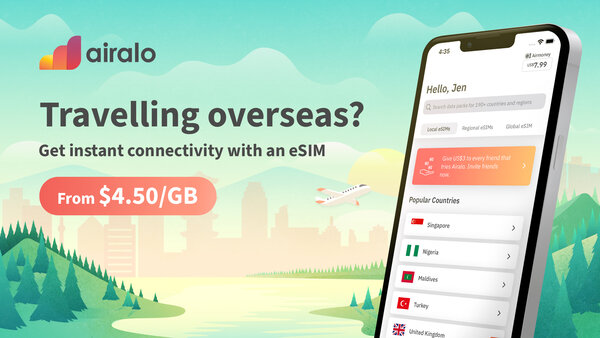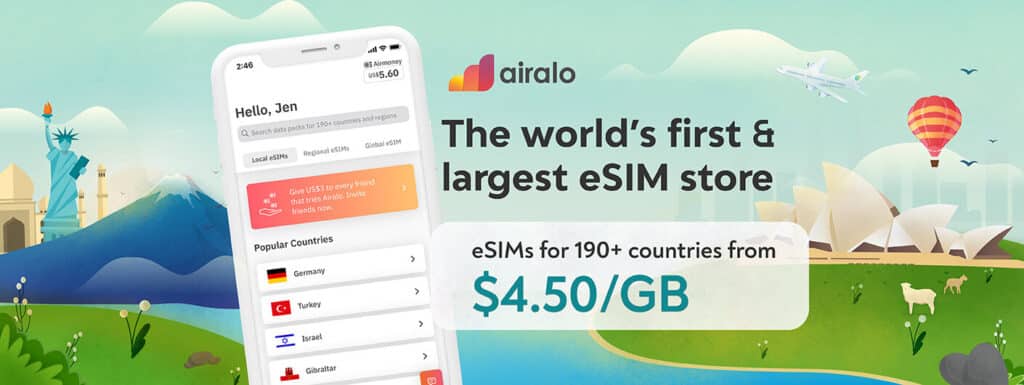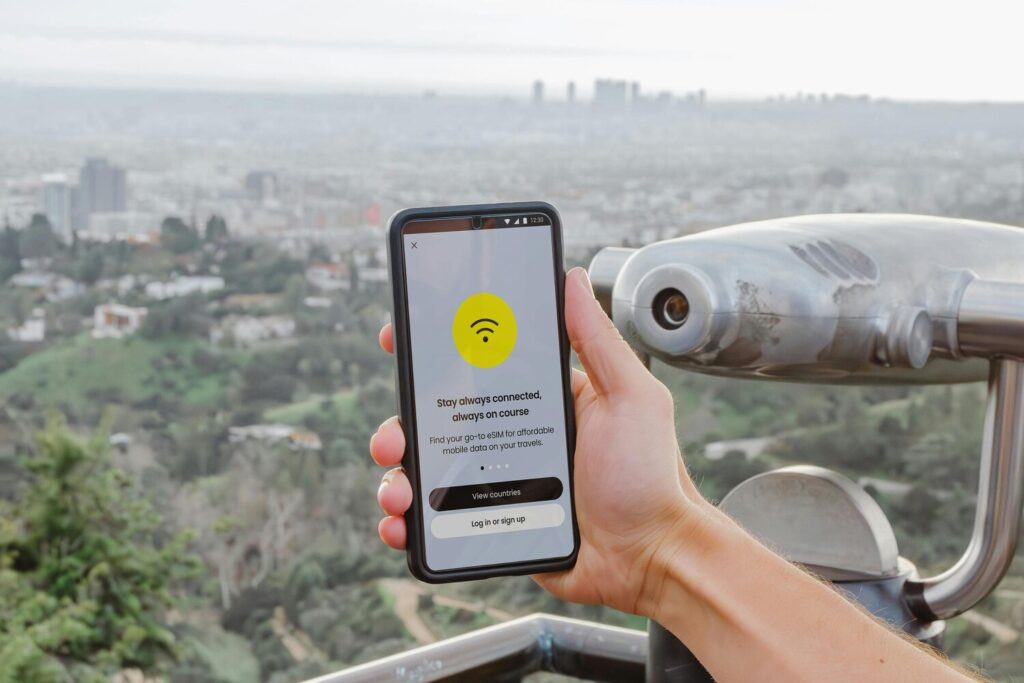
Best eSIM for Europe
Gone are the days of fumbling with teeny tiny little SIM cards at the airport or desperately searching for Wi-Fi in a foreign city. eSIMs are changing the game for international travelers, especially in Europe.
If you haven’t heard of them yet, eSIMs (embedded SIMs) are digital SIM cards that are built into your cell phone. That means that you no longer need to swap out physical cards or worry about losing them while you’re out and about. All you have to do is just scan a QR code, activate your plan, and boom, you’re connected – it’s that easy.
For travelers hopping between European countries, eSIMs are a lifesaver. Instead of dealing with expensive roaming fees or hunting for a new SIM in every country, you can switch networks instantly and keep your number active across multiple locations – you’ll just have to select the best eSIM for Europe (with phone number included). Plus, most eSIM plans are way more affordable than traditional roaming charges, offering data-only plans or full-service options at local rates.
Another huge perk? You can have multiple eSIM profiles on one device. That means you can keep your regular number while also using a local European plan for data – ideal for staying in touch without draining your bank account, because buying loads of specific local SIMs along with new data plans gets expensive real quick. And, the good news is that with major carriers and travel SIM providers jumping on the eSIM bandwagon, finding a plan that works in Europe has never been easier.
So whether you’re backpacking through Italy, working remotely in Spain, city-hopping in Germany, or doing all the above, an eSIM makes staying connected effortless. No lines, no hidden fees, just seamless connectivity wherever you go. Welcome to the future of travel – you’re welcome in advance.
Let’ get cracking on all you need to know about finding the best eSIM for Europe.
How Do eSIMS Work In Europe?
If you’ve ever had to pop out a SIM card with a paperclip in a random café somewhere in a foreign country, you know the struggle of staying connected while traveling.
Enter eSIMs – the digital SIM cards that make European travel an absolute breeze. Unlike traditional SIMs, which require you to physically swap out criminally small plastic cards, eSIMs are built right into your phone, meaning no fuss, no tiny tools, and definitely no risk of dropping your SIM down a drain.
So, how do you get one? It’s actually ridiculously easy. Most providers will send you a QR code, and then all you have to do is just scan it, follow a couple of prompts, and you’re set.
No QR code? No problem. You can also manually enter the details or download an app from the carrier to activate it in seconds. That’s it – no spending hours hunting for a SIM store, no awkward conversations in broken French or Spanish.
But, hold your horses – before you get too excited, check if your phone is eSIM-compatible. Most newer iPhones (XR and later) and high-end Android devices (like Google Pixel and Samsung Galaxy S20 and up) support eSIMs. And even better, if your phone has dual SIM capabilities, you can even keep your regular number active while using a European eSIM for data – perfect for staying connected without insane roaming fees.
With eSIMs, traveling across Europe through multiple countries has never been smoother. Whether you’re snapping pics in Rome, navigating the Tube in London, or café-hopping in Amsterdam, you’ll always have fast, reliable data at your fingertips – no SIM-swapping required.
Advantages of Using eSIMS for Travel
Traveling through Europe should be about soaking up the sights, eating way too many pastries, and getting lost without a care in the world – not stressing about SIM cards.
That’s where eSIMs come in, making international connectivity effortless, hassle-free, and way more affordable.
No More SIM Card Juggling
Gone are the days of prying open your phone with a paperclip, trying not to drop a microscopic SIM card on the airport floor.
With eSIM technology, everything is digital – just download your plan, activate it, and you’re online in minutes. Whether you’re strolling along the Seine or hiking the Alps, staying connected has never been this easy.
Say Goodbye to Ridiculous Roaming Fees
Nothing ruins a trip faster than checking your phone bill and realizing you’ve been charged the price of a plane ticket just for using Google Maps – and honestly, this isn’t really that much of an exaggeration, it’s so expensive! eSIMs help you dodge outrageous roaming fees by offering access to local or regional plans at reasonable prices. More Euros in your pocket means more gelato in Italy or extra pints in Ireland – that’s the ultimate goal, right?
Seamless Connectivity Across Borders
Europe is a dream for travelers – one moment you’re in Spain, and a quick train ride later, you’re in Portugal.
The only problem? Traditional SIM cards don’t always keep up. With an eSIM, you can store multiple data plans and switch between networks effortlessly, making them especially useful while you’re in Europe since you’re likely to be hopping between a few different countries. So, whether you choose a country-specific plan or a Europe-wide package, your phone stays connected wherever you go.
Instant Activation, Anytime, Anywhere
Forgot to buy a SIM before you landed? No stress. eSIMs can be activated within just a few – all you need is Wi-Fi, which, these days, you’ll find around just about every corner. Just scan a QR code, follow a few simple steps, and you’ll be online in no time. No more running around looking for a mobile store after a long-haul flight – and thank goodness, because let’s be honest, that’s a nightmare.
More Secure and Reliable
Losing a physical SIM card is an easy way to ruin a trip – it’s like throwing money away. But eSIMs live inside your phone, meaning there’s no risk of misplacing or damaging them (unless you lose the whole phone, of course). Whether you’re booking last-minute train tickets or posting that perfect sunset shot from Santorini, your connection is always within reach.
In short, eSIMs make travel stress-free, affordable, and ridiculously convenient – exactly how it should be.
Key Factors to Consider When Choosing an eSIM Provider In Europe
If you’ve decided to ditch the old-school SIM, that’s a great first step to stress-free travel. But, with so many eSIM providers out there, how on earth are you supposed to pick the right one? Well, don’t fret, I’ve got you covered.
Here’s what you need to consider before hitting that “buy now” button.
Coverage: Does It Work Everywhere You’re Going?
Not all eSIMs are the same in any stretch of the imagination. Some cover just a few countries, while others offer Europe-wide plans, so it all depends on what you’re planning on doing.
If you’re hopping between Paris, Berlin, and Rome, a regional eSIM covering all of Europe is your best bet. But, if you’re only spending a week in Spain sipping sangria, a country-specific plan might save you some cash, because you just don’t need access to the rest of the continent.
But, always check which countries are included, because trust me, the last thing you want is to lose connection the moment you cross a border.
Data Plans and Pricing: What’s the Best Deal for You?
eSIM providers offer a range of plans, from pay-as-you-go to unlimited data. If you’re glued to Google Maps and Instagram, an unlimited plan is definitely your safest bet.
But, if all you need is to occasionally check messages and directions – or if you’re traveling on a budget – a fixed-data plan like 5GB for 30 days might be enough. Just watch out for sneaky hidden fees – they often pop up!
Speed and Network Quality: To 4G or To 5G?
You don’t want to be stuck on slow 3G while trying to stream your Eurotrip vlog. Look for providers that offer 4G or 5G connectivity and partner with major European networks like Vodafone, Orange, or Telekom.
It’s good to be aware of the fact that some budget-friendly eSIMs cut costs by using slower networks, so always check the fine print.
Device Compatibility: Is Your Phone eSIM-Ready?
Not every phone is on board with eSIM technology. iPhones from the XS onwards support eSIMs, as do many newer Samsung, Google Pixel, and some Huawei models.
But here’s where the issue comes in. If you’re using a budget or older phone, double-check before purchasing, because nothing’s worse than buying an eSIM that won’t work on your device.
Validity and Expiration: How Long Will Your eSIM Last?
Some eSIMs expire after seven days, some after 30, and others let you top up indefinitely which can be cool if you’re traveling long-term or if you travel often – then you’ll want one that offers flexibility.
Just always check how long the plan is valid and whether it allows extensions – you don’t want to run out of data in the middle of a remote Tuscan vineyard (although I’m sure there are a few things you could do to pass the time).
Customer Support and App Experience: Will They Help If Something Goes Wrong?
Let’s be real – tech can be temperamental. If your eSIM refuses to activate just as you’re trying to book a last-minute Ryanair flight, you’ll want a provider with responsive customer support. Also, some providers have super user-friendly apps, making it easy to monitor usage and top up data, so try and check this out before you commit.
Top 10 Best eSIM Providers for International Travel in Europe
Airalo: Best for Global Travelers
Airalo is one of the best eSIMs for Europe as well as most of the rest of the world, offering affordable plans in over 190 different countries. Its regional plans make it a great choice for travelers moving between multiple destinations.
- Coverage: 190+ countries, including all of Europe.
- Pricing: For a European eSIM, $5 for 1GB (7 days), $20 for 10GB (30 days).
- Speed and Network: 4G LTE in most locations, and some regions have access to 5G.
- Best For: Budget-conscious travelers, backpackers, and those exploring multiple countries in one go.
Pros:
- Wide global coverage
- Affordable plans
- Easy activation via the app.
Cons:
- Data-only – no calls or SMS
- Speeds may vary in rural areas
Nomad: Best for Regional Flexibility
Nomad offers flexible eSIM plans that cater specifically to regional travel, which makes it perfect for those visiting multiple European countries.
- Coverage: Europe, North America, Asia, and Australia.
- Pricing: You’ll pay $18 for 5GB (30 days), $40 for 20GB (30 days) on a European plan.
- Speed and Network: 4G LTE with 5G access in select cities.
- Best For: Tourists and short-term travelers who prioritise flexibility.
Pros:
- Wide regional coverage
- Easy setup via the app
- No hidden fees
Con:
- No voice or SMS support
- Speeds may drop during peak hours
Holafly: Best for Unlimited Data Plans
Holafly is known for its unlimited data plans, ideal for travelers who need constant internet access for work or entertainment.
- Coverage: Covers 40+ European countries
- Pricing: Unlimited Europe Plan at $27 for 5 days, $47 for 15 days
- Speed and Network: 4G LTE in most major cities
- Best For: Digital nomads, remote workers, and content creators
Pros:
- Unlimited data with no speed caps
- 24/7 customer support
- No roaming fees
Cons:
- No SMS or voice calls
- More expensive than other providers
GigSky: Best for Business Travelers
GigSky provides reliable internet access in over 190 countries – great for business travelers who need a dependable connection.
- Coverage: 190+ countries, including all of Europe
- Pricing: $9 for 1GB (7 days), $25 for 5GB (30 days) on the European plan
- Speed and Network: 4G LTE in most locations
- Best For: Business professionals and corporate travelers
Pros:
- Reliable connection
- Multiple plan options
- Available in almost every country
Cons:
- Data-only – no calls or texts.
- Can be expensive for heavy users.
Truphone: Best for Seamless Activation
Truphone is a premium eSIM provider offering seamless connectivity with easy activation and a user-friendly app, making this a go-to if you’re looking for the best eSIM card for Europe.
- Coverage: Covers 80+ countries, including all major European destinations
- Pricing: On the European plan, $15 for 3GB (30 days), $39 for 20GB (30 days)
- Speed and Network: 4G LTE with some 5G availability
- Best For: Frequent flyers and business travelers
Pros:
- Supports calls, texts, and data
- Easy setup
- Works in multiple regions
Cons:
- More expensive than competitors
- Limited coverage in rural areas
Ubigi: Best for Long-Term Travelers
Ubigi is a great choice for travelers spending extended time in Europe, as it offers affordable monthly data plans.
- Coverage: All of Europe, as well as North America and Asia
- Pricing: For a European plan, $8 for 3GB (30 days), $19 for 10GB (30 days)
- Speed and Network: 4G LTE with 5G in select cities
- Best For: Digital nomads and long-term visitors
Pros
- Affordable long-term plans
- Strong coverage in urban areas
- Easy app-based management (possibly one of the best eSIM apps for Europe)
Cons:
- No calls or SMS
- Speeds can be slower in some remote areas
Simtex: Best for Affordable Data in Asia
Simtex is probably one of the best-priced eSIMs, offering some of the cheapest data plans, especially for those traveling beyond Europe.
- Coverage: All of Europe as well as Asia and parts of North America.
- Pricing: $6 for 1GB (7 days), $25 for 10GB (30 days) for a European plan.
- Speed and Network: 4G LTE across most locations
- Best For: Budget-conscious travelers and students
Pros:
- Cheap rates
- Reliable coverage
- Easy activation
Cons:
- No SMS or voice calls
- No unlimited plans
KnowRoaming: Best for Frequent Travelers
KnowRoaming is designed for people who travel often and need a reliable connection across all of Europe (and possibly further).
- Coverage: Covers over 200 countries, including all of Europe.
- Pricing: For a European plan, $10 for 1GB (7 days), $40 for 10GB (30 days).
- Speed and Network: 4G LTE with 5G in select locations.
- Best For: Frequent travelers and business professionals.
Pros:
- Global coverage
- Competitive pricing
- Pay-as-you-go option available.
Cons:
- No options for unlimited plans
- Might need a manual APN setup
BNESIM: Best for Flexible Pay-As-You-Go Plans
BNESIM allows you to create a custom plan which is perfect for those who want flexibility in data, calls, and texts – you can pick exactly what you want for each, making this potentially the best eSIM for Europe travel in terms of flexibility.
- Coverage: 170+ countries, including all of Europe
- Pricing: Custom pricing based on usage
- Speed and Network: 4G LTE with 5G access in some locations
- Best For: Business travelers and those who want full flexibility
Pros:
- Supports calls, texts, and data – possibly the best SIM for data and calls in Europe
- Customisable plans
- No expiration on data
Cons:
- Setup can be complex
- Can be expensive if you’re going to use data heavily
Flexiroam: Best for Multi-Country Travel
Flexiroam offers convenient global eSIM solutions, so it’s a solid choice for travelers hopping between multiple countries, especially while on a Euro trip.
- Coverage: 150+ countries, including the whole of Europe
- Pricing: In Europe, $12 for 3GB (30 days), $35 for 10GB (30 days)
- Speed and Network: 4G LTE coverage
- Best For: Multi-country travelers and tourists
Pros:
- Wide coverage
- Easy top-ups
- Works in remote areas
Cons:
- No unlimited plans
- Can’t SMS or make calls
How to Set Up an eSIM for International Travel to Europe
Setting up an eSIM for your European travels is actually pretty quick and easy. Here’s how to get started:
Step 1: Ensure Your Phone Supports eSIM
Before you do anything, verify that your phone is eSIM compatible. Most newer iPhones and many Android devices support eSIM, but it’s a good idea to confirm your device’s specifications first to avoid any surprises – it’s not worth the headache.
Step 2: Choose the Right Provider for Your European Travel
Select an eSIM provider that covers the countries you’re planning to visit in Europe. Providers like Airalo, Holafly, and Nomad offer plans tailored to specific regions or even global coverage, so choose one that fits your travel itinerary (or that just covers the whole continent).
Step 3: Buy a Plan and Receive a QR Code
Once you’ve selected a provider, buy your data plan. Normaly, the provider will send you a QR code via email or through their app for easy activation.
Step 4: Scan the QR Code to Install the eSIM
Go to your phone’s settings, find the “Mobile Data” or “Cellular” section, and select “Add eSIM.” Scan the QR code you received, and your phone will automatically install the eSIM – it’s as easy as that.
Step 5: Set Your eSIM as the Primary Data Source
Make sure your new eSIM is set as the main data provider when you want to use it. This ensures it takes precedence when connecting to European networks.
Step 6: Test Your eSIM Connectivity Before You Travel
Before you head off, test your eSIM to ensure it’s working. Connect to mobile data and check if the internet is running smoothly. A quick test now will save you from issues once you arrive in Europe.
eSIM Vs. Local Sim Vs. Roaming: What’s the Best Choice When You’re Traveling In Europe?
When it comes to staying connected during your European travels, you have three main options: eSIM, local SIM, and roaming.
Here’s how each one compares for travel in Europe:
Cost:
- eSIM: Generally, eSIMs are more affordable than roaming, because they avoid the high roaming charges that can add up really Providers offer competitive rates without the added fees that come with traditional roaming. Of course, if you’re looking for the best eSIM for Europe, unlimited data is probably what you’re hoping for, so while you might not find that exactly, you may very well find affordable options.
- Local SIM: Local SIM cards tend to be the cheapest option, particularly for longer stays. However, you’ll need to purchase a new SIM in each country you visit, so this ends up being a nightmare if you’re traveling across lots of different countries in Europe.
- Roaming: Roaming is widely known to be the most expensive option, especially for data-heavy activities like streaming or using GPS. Charges can vary, but they often come with steep costs for data usage outside of your home network.
Ease of Use:
- eSIM: eSIMs are incredibly convenient for European travel because there’s no need to swap out physical SIM cards – it just doesn’t get easier. Activation is fast and can often be done digitally, making them ideal for short to mid-term trips or multi-country travel across Europe.
- Local SIM: While local SIMs are affordable, they require more effort to acquire. You’ll need to find a store, purchase the SIM, and manually replace your existing SIM card, which can be time-consuming if you’re hopping between countries.
- Roaming: Roaming is the easiest option in terms of set-up – you don’t need to physically swap anything, just adjust a few settings on your phone. However, it’s often pricier than the other two options.
Speed and Quality:
- eSIM: eSIMs provide access to reliable 4G and 5G networks in most European countries. You’ll generally get fast speeds and solid coverage, especially in larger cities.
- Local SIM: Like eSIMs, local SIMs often give you good speeds and reliable connections, especially in more populated areas. But, if you’re traveling to remote locations in Europe, you might experience varying network coverage, so bear this in mind while planning.
- Roaming: Roaming can provide 4G or 5G access, but speeds can be throttled, particularly in rural areas or outside major European cities. Data speeds are often slower, making eSIMs and local SIMs a better choice for consistent service.
Availability:
- eSIM: eSIM availability has increased in Europe, but it’s not yet universally available in all countries or for all providers. Still, most major European countries offer eSIM options, especially in tourist hotspots.
- Local SIM: Local SIM cards are widely available once you arrive in Europe, with many shops and kiosks offering them at airports or in city centres. But, you’ll need to purchase a new one for each country you visit, which can be a nightmare.
- Roaming: Roaming is available in virtually every country in Europe, but depending on your home carrier, it might not always be the most cost-effective option in fact, it’s normally not).
When to Choose Each Option:
So, with all this information in mind, what eSIM is best for Europe? Well, here’s what each type is best suited for:
- eSIM: Opt for an eSIM if you’re traveling across multiple countries in Europe for a short to mid-term trip. It’s convenient, offers competitive pricing, and can be activated without the need for physical SIM card swaps.
- Local SIM: If you’re planning to stay in one country for an extended period, a local SIM tends to be the best and most affordable choice. It’s especially cost-effective if you’re staying in a specific region of Europe for a longer duration.
- Roaming: Choose roaming if you’re looking for a simple, hassle-free option and don’t mind paying a little extra for the convenience. It’s also useful if you need immediate connectivity in an emergency situation and don’t have the time to deal with purchasing a SIM or activating an eSIM.
FAQs About eSIMS for International Travel
Can I use multiple eSIMs on one device?
Yes, most modern smartphones, including recent iPhones and Android devices, allow you to store multiple eSIMs. But, you can normally only use one eSIM at a time for mobile data. This is great for European travel, because it means you can switch between eSIMs for different countries or keep a backup plan ready.
What happens if I run out of data?
If you run out of data while traveling in Europe, you can usually top up your eSIM through the provider’s app or website, which is super easy. Plenty of eSIM providers offer quick recharge options, so you won’t need to buy a new plan or reinstall the eSIM.
Can I use an eSIM alongside my regular SIM card?
Almost always. Most dual-SIM phones allow you to use an eSIM for data while keeping your regular SIM active for calls and texts. This is useful if you want to stay connected with your home number while using an eSIM for affordable data in Europe – the best of both worlds.
Is an eSIM more secure than a physical SIM?
Yes, eSIMs are generally more secure because they can’t be physically stolen or swapped like traditional SIM cards. They also protect against SIM card cloning, a common form of fraud, which is a bonus.
How do I delete or switch between eSIMs?
You can manage your eSIMs in your phone’s settings under the “Mobile Data” or “Cellular” section. Most devices let you switch between eSIMs with a few taps or delete an old eSIM when you no longer need it.
Conclusion and Final Recommendations
Traveling around Europe should be all about exploring new places, indulging in amazing food, and snapping Insta-worthy pics – not finding local sim cards, worrying about money, and freaking out about losing SIM cards.
That’s where eSIMs come in! They make staying connected effortless, letting you activate a plan in minutes and enjoy fast, reliable data across multiple countries. No more hunting down local SIMs or dealing with overpriced roaming charges.
The best part is that there’s an eSIM for every kind of traveler. Whether you’re hopping between cities, working remotely, or just need unlimited data for all those Google Maps searches, you’ll find a plan that fits. Plus, with instant activation and no need for a physical SIM swap, you can set everything up before you even take off.
Before your trip, just double-check that your phone supports eSIMs, pick a provider that covers the places you’ll be visiting, and grab a plan that suits your needs. A little prep now means a hassle-free, connected adventure later.
So go on, then – explore Europe without missing a beat (or an important WhatsApp message)!









Responses